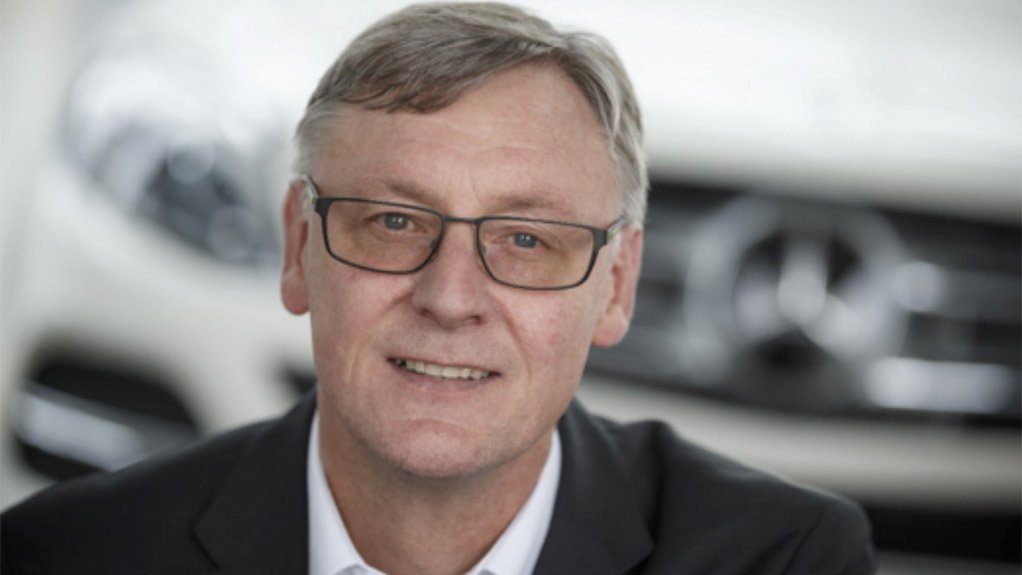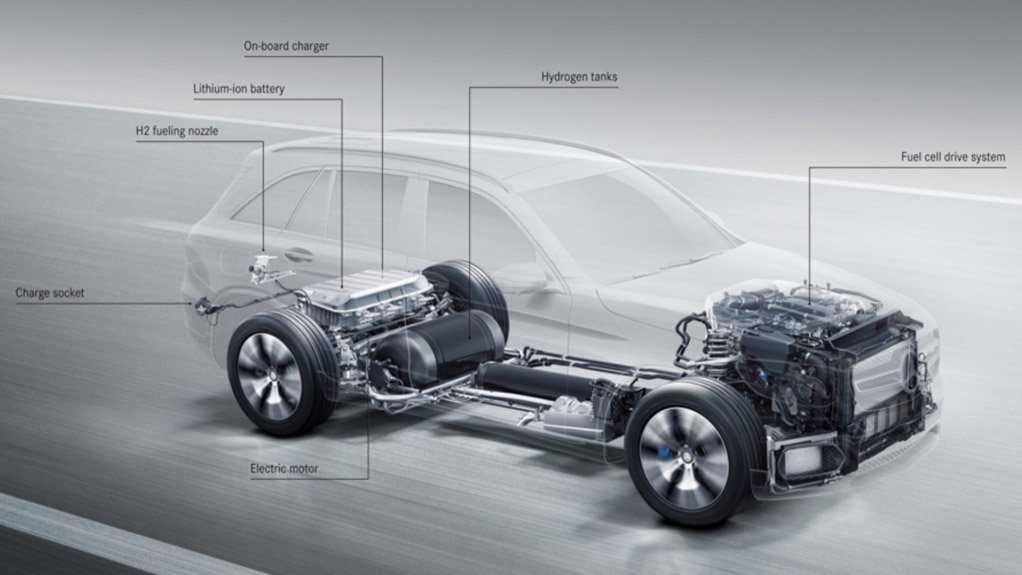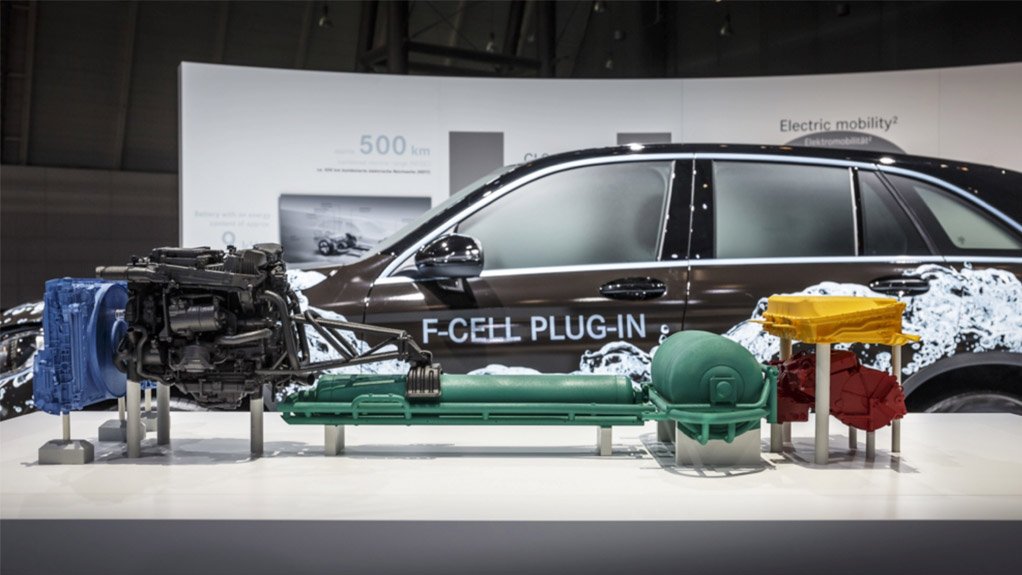JOHANNESBURG (miningweekly.com) – German car manufacturer Daimler has cut the platinum loading of its new fuel cell Mercedes to catalytic converter level.
“We reduced the amount of platinum by 90%, which provides a significant cost reduction. Our fuel cell is not much above the platinum loading of a catalytic converter on a conventional car,” Daimler fuel cell director Professor Dr Christian Mohrdieck has told cH2ange, an organisation promoting a global switch to the hydrogen economy to mitigate climate change.
Reducing the platinum loading of catalysts has for long been seen as a necessary step towards increasing the economic viability of fuel cell electric vehicles.
Isondo Precious Metals CEO Vinay Somera tells Creamer Media’s Mining Weekly Online that an internal combustion engine car uses between 3 g to 5 g of platinum in a catalytic converter.
Isondo is planning to establish a fuel cell component manufacturing plant in South Africa, using state-of-the-art German technology for membrane electrode assembly and targeting companies such as Daimler, Toyota, General Motors, Renault, Nissan, Volkswagen, BMW and Honda.
Hydrogen fuel cells are made up of membrane electrode assemblies that together form the fuel cell stack.
Refuelled in three minutes, the soon-to-be-launched Mercedes has a 500 km range, plus exceptional acceleration from an electric drivetrain that provides instantaneous torque, even at zero rotation per minute.
The 150 kW or 204 hp GLC F-CELL Mercedes offers an emission-free combination of fuel cell and plug-in battery facilitation.
The car’s manganese-using 9 kWh lithium battery, which provides the car with additional 50 km range, has an onboard charger for recharging at any socket, which allows for the progressive build-up of hydrogen infrastructure. The latest edition of Fortune magazine lists lists South Africa and Australia as the sole suppliers of 100% of the manganese brought into the US for use in lithium-ion batteries.
Mercedes' platinum-catalysed fuel cell electric vehicle is earmarked for initial sale in Germany, California and Japan, where hydrogen infrastructure is being progressively provided.
Germany aims to have 400 hydrogen stations by 2023, California aims to have 500 hydrogen stations by 2022 and Japan already has more than 80 hydrogen stations. In Hamburg, hydrogen refuelling facilities must be provided at all new filling stations.
Mohrdieck foresees the emergence in the mid- and long-term of a mix of battery electric vehicles for short-distance travel and overnight home recharging, and the growing use of fuel cell electric vehicles for longer-distance travel that requires quick refuelling.
“Fuel cell vehicles will reach higher production numbers soon,” predicts Mohrdieck, a viewpoint that is shared by Japanese car company Toyota, which has the fuel cell Mirai car.
The only emission while driving is water and the goal is to produce hydrogen from wind and solar energy, which will mean that hydrogen will be produced with zero carbon emission.
The plans of the mayors of the world’s biggest cities to tackle urban air pollution head-on are a major boost for fuel cells and the platinum that catalyses them.
The clean-air programme is being spearheaded by C40 Cities Climate Leadership Group, which connects more than 90 of the world’s greatest cities, representing 650-million-plus people and a quarter of the global economy.
The tackling of city air pollution gathered momentum in March when Paris mayor Anne Hidalgo, who is the C40 chairperson, and London mayor Sadiq Khan, vowed to get rid of dirty urban air that is a serious health hazard.
Their action prompted a response from World Platinum Investment Council (WPIC) CE Paul Wilson, who expressed the WPIC’s keenness to contribute to the initiative by way of fact-rooted dialogue and focussed proactivity.
WPIC was created three years ago by South African platinum-mining companies Anglo American Platinum, Aquarius Platinum, Impala, Lonmin, Northam and Royal Bafokeng Platinum.
In a comprehensive address to the Investing in African Mining Indaba earlier this year, Ivanhoe Mines executive chairperson Robert Friedland flashed on to a big screen graphics of platinum-catalysed fuel cell vehicles that end the era of tiny particles in the air of major urban cities entering the lungs, getting into the blood stream and going permanently beyond the blood brain barrier.
Three-term New York mayor Michael Bloomberg serves as president of the C40 board and other signatories include Cape Town mayor Patricia de Lille as well as Los Angeles mayor Eric Garcetti, Boston mayor Martin Walsh, Copenhagen mayor Frank Jensen, Mexico City mayor Miguel Ángel Mancera and Milan mayor Giuseppe Sala.
In January, the World Economic Forum in Davos declared hydrogen to be the clean fuel that can take the planet into a no-carbon future, on the back of technology breakthroughs that include liquefied hydrogen now being safely transportable in much the same way as oil.
The 13 companies involved included platinum-producing group Anglo American, which acted in concert with Air Liquide, Alstom, BMW Group, Daimler, Engie, Honda, Hyundai, Kawasaki, Royal Dutch Shell, Linde, Total and Toyota and wanted by them is an exponential acceleration of the €1.4-billion yearly investment already under way to attain the Paris Agreement’s target of reducing temperatures to 2 °C below pre-industrial levels.
Governments the world over have been urged to support large-scale investment in hydrogen infrastructure so that platinum-catalysed fuel cells can provide clean, noiseless, low-maintenance and competitive electricity in mobile and stationary applications across the industrial, commercial and residential spectrum.
“Our call to world leaders is to commit to hydrogen so that together we can meet our shared climate ambitions and give further traction to the emerging hydrogen ecosystem,” Air Liquide CEO Benoît Potier urged at the World Economic Forum.
Toyota chairperson Takeshi Uchiyamada committed his company to doing everything possible to emphasise hydrogen’s crucial role in decarbonising the global economy and Anglo American CEO Mark Cutifani emphasised that hydrogen-powered fuel cell electric vehicles offered the most natural solution in that they require little change to current driving and refuelling habits.
In converting chemical energy from a fuel into electricity through a reaction of positively charged hydrogen ions with oxygen, fuel cells are already powering forklifts at Impala Platinum’s refinery in Springs, where they are acclaimed as emission-free and noiseless performers.
Their success has been so marked that steps are now being taken to develop fuel cell load haul dumpers for use in underground mines.
On the stationary power front, an 8 MW off-grid power plant from a platinum-catalysed fuel cell system has also passed competitive muster within the Impala Platinum refinery precinct, where a heat-integrated fuel cell plant beat State-owned power utility Eskom’s megaflex tariff over the 20-year power price agreement.
EMAIL THIS ARTICLE SAVE THIS ARTICLE ARTICLE ENQUIRY
To subscribe email subscriptions@creamermedia.co.za or click here
To advertise email advertising@creamermedia.co.za or click here















